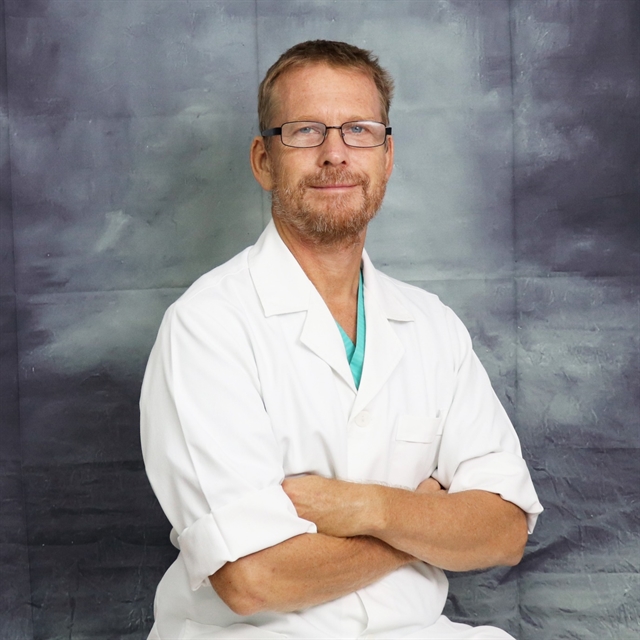Infection
Mysterious skin disease in a child with frequent infections
| Dr Mattias Larsson. Photo courtesy of Family Medical Pratice |
Dr Mattias Larsson*
Phương is an 8-year-old usually vibrant and active girl that likes to play with friends, she is good at sports like football and achieves well in school. However, she had been increasingly sick the last seven months. Her parents took her to many doctors and she was diagnosed with several episodes of respiratory infections as well as diarrhoea and consequently was treated with antibiotics several times. The last two weeks she had developed small black dots all over the body as well as weight loss, fatigue, fever, cough, difficulty breathing, abdominal pain and diarrhoea. She was admitted into the local paediatric hospital that diagnosed pneumonia and treated her with IV antibiotics which gave some temporary relief. She was discharged but the symptoms still progressed.
Phượng’s parents grew increasingly desperate, as black skin dots spread across her face, her weakness intensified and she completely lost her appetite. They took her to Family Medical Practice where she was examined by a paediatrician, who detected also swollen lymph nodes and an enlargement of the liver and spleen. As the paediatrician had previously worked with immunosuppressed children he recognised the black dots as a very rare fungal infection, talaromycosis. Microscopic examination and fungal cultures from skin and blood confirmed the diagnosis.
Talaromycosis is a systemic mycosis caused by the fungus Talaromyces marneffei, that is only present in Southeast Asia, southern China and eastern India. It can affect the whole body. Most people who get talaromycosis have a medical condition that weakens their immune system.
Phương tested positive for HIV. Her number of white blood cells CD4 was very low, indicating a severe immunodeficiency. She most likely had been infected for a long time. The viral load, the amount of HIV virus in the blood, was very high.
HIV is a viral infection that spreads through direct contact with infected blood. This can occur through sexual intercourse when there is blood contact due to small lesions, as well as through blood transfusion or transmission from an infected mother to her child during pregnancy or breastfeeding. The HIV virus infects CD4 cells, white blood cells defending the body against infections, and turns them into virus factories producing more virus particles. This cycle continues, infecting additional CD4 cells and progressively weakening the immune system. As a result, the ability to protect against infections decreases over time. After an average of about eight years the immune system is so weak that there is risk of opportunistic infections such as tuberculosis, pneumocystis pneumonia, cryptococcus meningitis and, as in Phuong’s case, talaromycosis. Globally there are about 40 million people living with HIV, of these about two million are children, the majority in sub-Saharan Africa. In Việt Nam about 215,000 are living with HIV, including about 5,000 children.
When the parents were informed, they told the doctor that Phương had been adopted when she was very young from a relative that suddenly died, most likely due to suicide covered up as an accident. They had never told Phương and did not have much information about any condition that the relative might have had.
Phương was referred to a paediatric HIV care and treatment centre where the talaromycosis was treated with the fungal drug Amphotericin. She improved fast, the black dots in the skin disappeared and she gained weight. She was also promptly initiated on lifelong treatment with antiretroviral drugs, a combination of three drugs in one tablet once per day that suppress the viral replication. This helped her immune system recover fast.
HIV is currently not curable, but with good adherence to the antiretroviral treatment it can be regarded as a chronic disease where you can live a perfectly normal life, just like diabetes. Phương learned how to take her medication by herself every day, she continued school with good results and did not have more sick leave then her peers. She could continue to play football and play with her friends. The parents learned more about HIV so they could support her with the treatment and follow up. Family Medical Practice
*Dr Mattias Larsson is a paediatric doctor at Family Medical Practice and associate professor at Karolinska Institutet and has a long experience in research on infectious diseases. He has worked with the Oxford University Clinical Research Unit and the Ministry of Health of Vietnam. He is fluent in English, Swedish, Vietnamese, German and some Spanish.
Visit Family Medical Practice Hanoi 24/7 at 298I P. Kim Mã, Kim Mã, Ba Đình.
To book an appointment, please call us at (024).3843.0784 or via Whatsapp, Viber or Zalo on +84.944.43.1919 or email hanoi@vietnammedicalpractice.com.
FMP’s downtown location in Hồ Chí Minh is in Diamond Plaza, 34 Đ. Lê Duẩn, Bến Nghé, District 1, Thành phố and 95 Thảo Điền, District 2. Tel. (028) 3822 7848 or email hcmc@vietnammedicalpractice.com.

